Toronto International Film Festival’s 35th birthday .. “Mother of Rock”
Sep 19th, 2010 | By Dominic Berry | Category: In Brief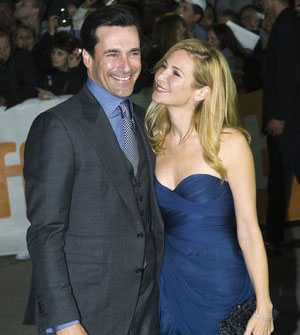
Jon Hamm, star of the best American TV series extant today, with his long-time partner Jennifer Westfeldt, at the Toronto International Film Festival 2010.
Overimpressed by Malene Arpe’s vain plea in the newspaper, “I wish that just once, everyone would turn on the glam for Toronto,” we had dressed up, slightly – or at least more than we usually do. It was strange enough that when our Rastifarian neighbour walked by, while we were waiting for the streetcar, he stopped and asked: “Are you going to the film festival?”
We confessed that we were – to see “Mother of Rock: Lillian Roxon,” directed by Paul Clarke and produced by Robert de Young (and based on a book by Robert Milliken).
Our neighbour had noticed some good reviews of this Australian documentary. He wasn’t familiar with Lillian Roxon, who chronicled the rock music scene focused on a club called Max’s Kansas City, in New York City, during the 1960s and early 1970s. (Neither were we.) But he was intrigued by what he’d read about the movie. (We are supposed to tell him what we thought of it, the next time we bump into each other on the street.)
I have two good friends, or more, whose wives drag them to meticulously selected assortments of the offerings at the Toronto International Film Festival every year. (And my friends may enjoy this more than they let on.) But my wife and I had never been before. Through a chain of events I don’t have time to go into here, this year’s 35th edition of “TIFF” turned out to be our chance to catch up with the local excitement, face to face.
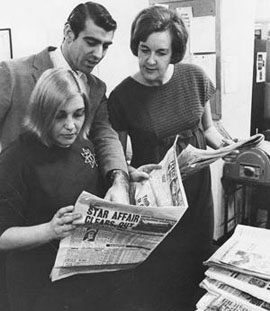
Lillian Roxon (lower left) in the Sydney Morning Herald’s New York office in the 1960s with Don Riseborough and Margaret Jones.
On a fine early fall evening (or technically still late summer?), we got off the streetcar at Yonge and Queen, and walked north up Yonge. Our movie was showing at the AMC 2, 10 Dundas East. We had never been there before either. As we walked up Yonge there was an almost interminable lineup on the street. (Looking at the TIFF Maps and Locations, I see it must have been for the VISA Screening Room & Winter Garden Theatre.)
The AMC venue at 10 Dundas East was not quite so crowded. Seating was first-come-first-served, and the line-up for the AMC 2 was comfortably installed in AMC 1. Inside AMC 2 at last the first showing of “Mother of Rock: Lillian Roxon” had not attracted huge numbers. But it was a respectable audience for an Australian documentary in North America. After some tedious commercials and promotional blurbs, the feature presentation began.
Germaine, Helen, Lillian, and Linda …
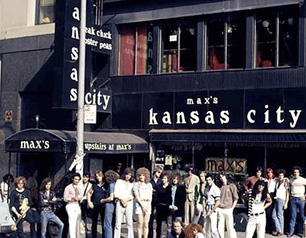
Max’s Kansas City back in the day, where Andy Warhol, Janis Joplin, Lillian Ronson, Willem de Kooning, and many others held court ... 213 Park Avenue South, between 17th and 18th streets, in Manhattan.
As the reviews read by our Rastifarian neighbour report, “Mother of Rock” is an “interesting and revealing documentary” and an “excellent record of a problematic but important rockin’ feminist pioneer.” That many of us in the TIFF audience in Toronto, Canada did not know much or at all about this Italian-born, Polish-Jewish-descended, Australian pioneer, who made her ultimate career as a journalist in New York City, only added to the intrigue.
It is also part of Lillian Roxon’s deeper fascination that, while you may not know about her, you probably have heard of many of her friends. And the list doesn’t just include the likes of David Bowie, Robert Mapplethorpe, Jim Morrison, Iggy Pop, Lou Reed, Patti Smith, and Andy Warhol, who also hung out at Max’s Kansas City (213 Park Avenue South, just north of Union Square, in Manhattan).
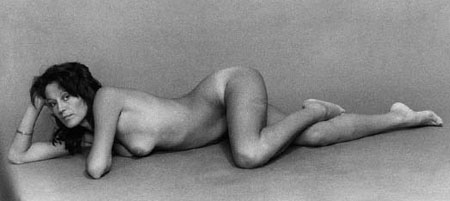
Germaine Greer, May 1971: the liberated woman in her prime. Photo Keith Morris : “This is one of Keith’s tamer studies of her.”
Ms. Roxon was a close if sometimes stormy friend as well of such globally known fellow Australians as Germaine Greer and Helen Reddy. (And Ms. Greer went out of her way to participate in the premiere of “Mother of Rock” at the Melbourne International Film Festival [MIFF] a few months ago.)
Lillian Roxon’s most famous (and for a time quite close) New York friendship may have been with Linda Eastman – the sometime photographer and daughter of the Scarsdale plutocracy who went on to marry Paul McCartney in 1969.
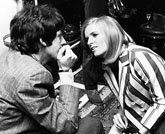
Linda Eastman and Paul McCartney at the press launch of Sergeant Pepper’s Lonely Hearts Club Band, 1967.
One source explains: “Lillian Roxon had been Linda’s closest friend from mid-1966 until Linda left for London in September ’68.” Another source says: “On a tip from the late rock authority, Lillian Roxon, Linda slipped touring Beatle McCartney a handwritten note with her telephone number. He called and they stayed the night together. When Paul returned later that year (1968), he rang her up …”
As summarized in Wikipedia: “Linda McCartney (then Linda Eastman) was one of Roxon’s closest female friends and she did much to further Eastman’s career, but the friendship ended abruptly in 1969 when Eastman moved to London, married Paul McCartney and cut all ties with all her former friends, a move which wounded Roxon deeply.”
To pour some long-overdue balm on this wound, perhaps, Linda McCartney was eager to be interviewed for the book on which the film “Mother of Rock” is based, author Robert Milliken revealed in the Q&A session at the end of the first AMC 2 presentation in Toronto. But her sad breast-cancer death in her late 50s, in 1998, foreclosed the prospect.
On-camera interviews with both Helen Reddy and especially Germaine Greer, however, figure prominently enough in “Mother of Rock.” And it may be especially interesting to see how they looked then – and now. (Perhaps especially if you know you don’t look quite as good as you used to think you did yourself.)
Iggy Pop, real star of “Mother of Rock” … and Dundas Square in Toronto?
The ultimate star of the Australian documentary on Lillian Roxon (1932—1973 ) – or the interviewee who at least adds the most to the enterprise – is probably Iggy Pop, aka James Newell Osterberg, Jr. (born April 21, 1947 in Muskegon, Michigan – west of Grand Rapids and close to Lake Michigan).
I can’t say that I knew much about this Iggy (as opposed to the Iggy who is Michael Ignatieff, current leader of the Liberal Party of Canada) before I saw “Mother of Rock.” I suppose I did vaguely grasp that he is “considered an influential innovator of punk rock, hard rock, and other styles of rock music” (Wikipedia). And I had an even vaguer sense that “Pop was the first performer to do a stage-dive … Other exploits … include rolling around in broken glass, exposing himself to the crowd, and vomiting on stage.”
From “Mother of Rock” I also learned that, in the golden age of the 1960s and 1970s at Max’s Kansas City in New York, a quite drugged-up and intoxicated Iggy Pop would, as part of his stage act, sometimes cut his chest with a knife to induce considerable blood on his body (typically bare-chested, even today at 63). His friends at Max’s would sometimes conclude that he was bleeding too much, wrap him in a blanket, and take him to the hospital (or so the survivors among them say now, with much amusement).
What I really wasn’t expecting, I suppose I ought to confess, is that, whatever you may think of his music (if that is quite the right word for it), Iggy Pop is a bright and articulate man with some shrewd and often amusing insights into American popular culture over the past half century. (Though this is hardly surprising when you think about it, no doubt, given what he has done in a career still in motion now in 2010, in his early 60s.)
At the Q and A after the first TIFF showing in the AMC 2, the three main Australian creators of “Mother of Rock” – writer and director Paul Clarke, producer Robert de Young, and author of the inspiring book, Robert Milliken – made clear enough, in various ways, that even without Iggy Pop they would have made an excellent Lillian Ronson documentary, because they were so interested in and had so much faith in the importance of their subject. And, as Paul Clarke explained to the TIFF audience, Iggy only agreed to be interviewed at the very last minute. He almost missed being in the film. Recurrent clips from a very intriguing interview with him, on Lillian Roxon, Max’s Kansas City, his kind of rock music, and America then and now, nonetheless lend “Mother of Rock” a distinction beyond mere excellence.

As the CBC explained: “Most of the crowd could not see a thing, but they could at least feel and hear the music bouncing off the buildings that close in the Square ... people made the best of it ... The energy was live, mostly generated from the man himself – Iggy Pop!,” who “looks basically the same as he always has, tight pants and bare-chested.”
My space here is fast running out, but I can’t resist two quick final allusions to Iggy Pop. First, as I have just now discovered on the net myself, there was a Toronto prelude to his TIFF appearance this year in “Mother of Rock.” As the current Wikipedia entry on him explains: “ In June 2010, Iggy Pop appeared at Yonge and Dundas Square in Toronto with the reformed Stooges on the NXNE main stage. The sheer size of the audience closed … [the] central artery of Yonge Street.” (For further documentation see: “Iggy closes Yonge St. June 19 2010 NXNE” ; “Iggyy & The Stooges — Gimme Danger live in Toronto NXNE” ; “Iggy sidestage June 19 2010 NXNE” ; and “Iggy exits June 19 2010 NXNE…wait until the end!”)
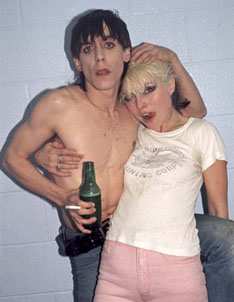
Iggy Pop with Deborah Harry, some years after Lillian Roxon’s death ... two more denizens of Max’s Kansas City in Manhattan, 1965—1981.
Finally, listening even very briefly to “Iggy and & The Stooges” at their June 19, 2010 Toronto appearance reminds me that I still don’t like their actual music myself. But I do infinitely admire some tunes from another group germinated by Max’s Kansas City in New York – Blondie, with the lovely (and effortlessly cool and satirical) Deborah Harry and her husband Chris Stein. Blondie came on the scene somewhat after Lillian Roxon’s untimely death in 1973, at the age of 41 (from some sort of extreme asthma attack, after a period of overwork, probably?). But Deborah Harry worked as a waitress at Max’s Kansas City for a time, when she first arrived in New York City in the late 1960s. And I still think that Blondie’s “global smash hit single” of 1978, the haunting “Heart of Glass” – even if it clearly is “disco” and not “punk rock” – is one of the great American pop tunes (and an early great video) of the later 20th century.
Canadian connections … Peter Desbarats and Aviva Layton
The editors are reminding me that my time really is expiring. So I’ll have to be very quick from here. But I feel somehow obliged to mention two particular Canadian connections to “Mother of Rock” that have at least intrigued me somewhat. (If you look hard enough it’s often enough easy to see some Canadian connections in Australian cultural products, and vice-versa ?)
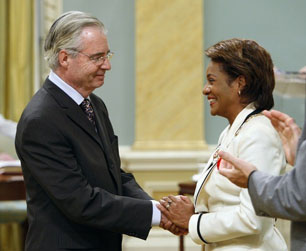
“Journalist Peter Desbarats is awarded the rank of Officer in the Order of Canada by Governor General Michaelle Jean at Rideau Hall in Ottawa October 26, 2007.”
First, there is a point fairly early on in the film when we are shown a neatly typed list that Lillian Roxon made of the various men she had been sleeping with – early on in her New York career, perhaps, when she was still somewhat cute and intriguing-looking, as well as already a bit chubby? (At least I think that’s what the list was about! It’s the kind of agreeably dense movie you need to see more than once, to get everything altogether or even more or less straight.)
I was intrigued to see the name of the former dean of journalism at the University of Western Ontario and former Maclean-Hunter chair of Communications Ethics at Ryerson University in Toronto, Peter Desbarats, on the list that jumped out from the AMC 2 screen at any rate. (As I should make clear, at the same time, “Mother of Rock” has certainly convinced me that sleeping with Lillian Roxon was some form of badge of honour – despite a few more negative “fat girl and group sex” comments from Germaine Greer. And it was all very long ago, without any implications, of course, for Mr. Desbarats’ life today.)
Further research on the net indicates that there are letters from Peter Desbarats to Lillian Roxon, during the period 1960—1969, still extant in the collection known as “Lillian Roxon –Â Papers, 1948-1974,” at the State Library of New South Wales.
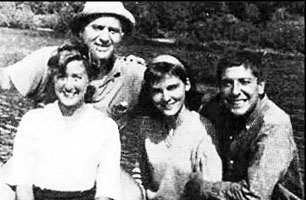
Left to right: Aviva Cantor (later Layton), Irving Layton, Anne Sherman, and Leonard Cohen, summer 1957.
Another Canadian-connected name from this same collection appears in several interview clips in “Mother of Rock.” This is Aviva Layton, who as Aviva Cantor moved from Australia to Montreal in the 1950s – and then spent more than 20 years with the Canadian poet Irving Layton (1912—2006). No doubt spending more than 20 years with this “quiet madman, never far from tears” qualifies as an achievement in its own right. And prior to “Mother of Rock” I at least only knew Aviva Layton through the Irving Layton poem, “The Day Aviva Came to Paris … The day you came naked to Paris/The tourists returned home without their guide books/The hunger in their cameras finally appeased.”
I now know as well that Aviva Layton was a particular friend of Lillian Roxon’s Australian youth, who continued to keep in touch with her friend in New York via the ancient art of letter-writing. No doubt, Aviva may have visited Lillian in New York occasionally as well, after she moved to Montreal. In any event, she is responsible for one of the more striking “Mother of Rock” remembrances of Lillian as a young Australian lady, which also appears in the preview on the TIFF website: “She looked like a Botticelli angel who’d just finished giving King Kong a blow job” (a line which, you might imagine, is equally amusing the ghost of Irving Layton that still haunts Côte-Saint-Luc in Montreal).
How good is TIFF … does it really make the “low self-esteem of Toronto (and of Torontonians) especially apparent”?
TIFF 2010 officially ends today, Sunday, September 19. Those who want some deep concluding remarks (which I have no more time to offer myself) could do a lot worse than read Kate Carraway’s “TIFF? Pffft…The film festival is great for the city, but it makes the low self-esteem of Toronto (and of Torontonians) especially apparent,” in the September 15 issue of EYE WEEKLY (actually September 16 on real-world newsstands).
I agree with at least half of what Ms. Carraway says – and maybe more (even though I am more than twice her age, and so forth). Note, eg: “When this shitty, seasonal behaviour (evidenced in deeply deferential coverage in local magazines and newspapers and blogs and Tweets) is compared to the much more critical and engaged commentary by industry attendees and show-and-party-crashing style bloggers at the TIFF-coinciding New York Fashion Week, Toronto seems especially, and needlessly, pathetic …
“It’s less TIFF-mania than it is TIFF-manic-depression: while the Toronto media working the festival reverentially cover the films and red carpets and parties and the constellation of movie stars spread out over Yorkville and King West, there is among us and the into-it TIFF ticket-holders a self-conscious, ironic excitement, and a lot of put-on, show-offy complaining about the exhaustion, the scheduling, the crowds.”
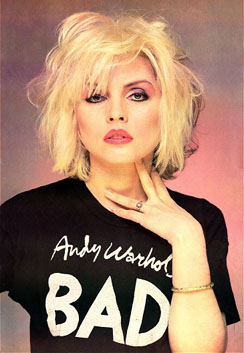
Deborah Harry: her turn as Blondie vocalist at Max’s Kansas City didn’t come until several years after Lillian Roxon’s unhappy early death. But it seems that Ms. Harry did serve an earlier apprenticeship as a waitress at Max’s, while Ms. Roxson was still alive.
Even so, from a distance I’ve always imagined, from what people I know who do go say, that the ultimate point for everyday movie-goers is to bump up against things you don’t know and would not ordinarily find much out about. When this really happens, you feel refreshed, and ready to confront the inevitable vast struggles of human life on this planet in some slightly new and better frame of mind. And that, I think, is at least a little how we felt, as we walked back south down Yonge Street to the Queen streetcar, after seeing “Mother of Rock: Lillian Roxon” at the AMC 2, fourth floor, 10 Dundas Street West – in a Canadian city with the heart of a loan shark that has far fewer elites these days than John Baird in Ottawa seems to understand.
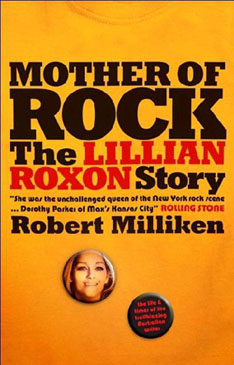
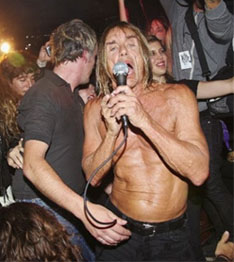
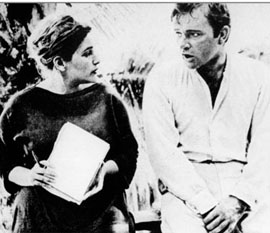
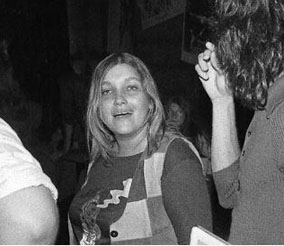
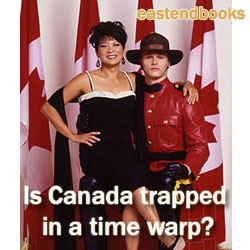
[…] Toronto International Film Festival’s 35th birthday .. “Mother of Rock†– Counterweights […]
http://www.urban-journal.com/2010/09/cool-graffiti-new-york-images-69/